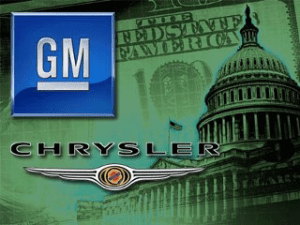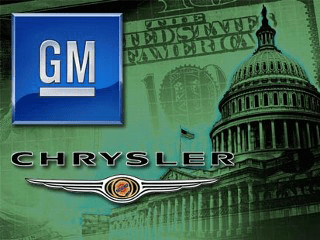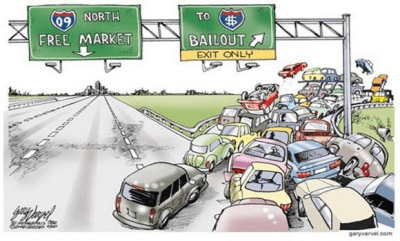
 The U.S. Treasury Department announced on Monday that it had sold its final shares of General Motors stock, officially ending the government bailout of GM at a loss of about $ 10 billion to the taxpayers.
The U.S. Treasury Department announced on Monday that it had sold its final shares of General Motors stock, officially ending the government bailout of GM at a loss of about $ 10 billion to the taxpayers.
The Center for Automotive Research (CAR) in Ann Arbor, Michigan, published a study that is supposed to prove that the government bailout actually benefited the taxpayers, because the damage to the U.S. economy would have been far greater if no action had been taken by the government. This publication makes perfect sense when you consider it were the same authors from the same research center that issued another memorandum back in November 2008, warning that as many as three million jobs were at stake in the automotive sector unless the U.S. government acted to guarantee the continued operation of all Big Three Detroit automakers.
Two scenario’s: dreamed up and imaginary
In CAR’s 2008 memorandum “The Impact on the U.S. Economy of a Major Contraction of the Detroit Three Automakers”, economic impacts were estimated for two scenarios involving a short-term, severe (50- or 100-percent) implosion of Detroit Three production in the United States. A great way to manipulate statistics and report results to validate one’s point of view is to base the study on fantasized data from a hypothetical worst-case scenario; in this case the scenario that if one of the Big Three were to go bankrupt, they would take down many suppliers with them, as a result also shutting down the remaining two Detroit automakers and foreign automakers with U.S. factories and the entire rest of the supply chain. The projections of job losses were based on the assumption that all automobile manufacturers and suppliers nationwide would be lost. Wow! Does that seem at all likely to anyone? Supporting these scenarios by over-informing the reader of the interdependence of the auto-supply industry that would lead to such a disastrous outcome, overshadows the fact that CAR did not study or hypothesize the more realistic scenario that GM and/or Chrysler or even Ford might seek Chapter 11 bankruptcy protection. That would enable them to reorganize, restructure and become healthy again without government intervention, like most other companies in this situation would. In that situation, auto suppliers would likely have had to take a loss, but it would certainly not have led to a domino-effect, knocking down an entire industry. Knowing that CAR is funded by automakers and other stakeholders of the U.S. auto industry, doesn’t that sound like the liquor store telling you that the drunk will die if you don’t give him money to “eat”?
Who’s paying the marriage portion?
 The only reason to even consider a government bailout instead of a regular chapter 11 bankruptcy procedure is that it was unclear whether GM would have been able to receive financing to operate during the bankruptcy, considering the credit problems in 2008 and 2009. If the treasury department had just guaranteed these loans instead of stepping in and taking over control, those $ 10 billion would not have come at a loss to taxpayers. But the Obama administration just didn’t trust General Motors enough to just give them the money and let the board do what was necessary. They wanted full control over what was done with the money. Now that’s a great foundation for a marriage.
The only reason to even consider a government bailout instead of a regular chapter 11 bankruptcy procedure is that it was unclear whether GM would have been able to receive financing to operate during the bankruptcy, considering the credit problems in 2008 and 2009. If the treasury department had just guaranteed these loans instead of stepping in and taking over control, those $ 10 billion would not have come at a loss to taxpayers. But the Obama administration just didn’t trust General Motors enough to just give them the money and let the board do what was necessary. They wanted full control over what was done with the money. Now that’s a great foundation for a marriage.
GM and Chrysler deserved to go out of business as a result of decades of bad management and greedy unions, but not at the cost of taxpayers and the free market system, as the bailout rewarded companies that had been inefficient and incompetent for years, and punished companies which had been more efficient, better at serving the customer and making products that Americans wanted to buy, who as a result didn’t need any subsidies to stay afloat. Ford avoided government subsidies because they pledged everything they had, even their trademark Blue Oval logo, as collateral for a loan from its creditors.
All is well that ends well?

 After five profitable quarters for GM, almost all who were involved in the bailout are congratulating themselves on the successful savings of the U.S. auto industry. But with a $ 50 billion cash infusion, wiped out debts, inefficiencies cut away and political obstacles steamrolled, all during a rapid recovery in U.S. auto sales, only the most incompetent companies could fail to make a profit. GM and Chrysler have been handed a rare second chance, but the cost to the terminated dealers, stockholders and the competition is overseen easily. Creating jobs is easy if you can use other people’s money for it. Creating wealth is a result of making cars that people want and that’s not easy at all. at Sure, the corporate culture in GM has changed for the better and the company is making better products and listening to the customer better than before, but that is a lesson that other companies learned without needing government to step in and taxpayers to pay for the tuition.
After five profitable quarters for GM, almost all who were involved in the bailout are congratulating themselves on the successful savings of the U.S. auto industry. But with a $ 50 billion cash infusion, wiped out debts, inefficiencies cut away and political obstacles steamrolled, all during a rapid recovery in U.S. auto sales, only the most incompetent companies could fail to make a profit. GM and Chrysler have been handed a rare second chance, but the cost to the terminated dealers, stockholders and the competition is overseen easily. Creating jobs is easy if you can use other people’s money for it. Creating wealth is a result of making cars that people want and that’s not easy at all. at Sure, the corporate culture in GM has changed for the better and the company is making better products and listening to the customer better than before, but that is a lesson that other companies learned without needing government to step in and taxpayers to pay for the tuition.
Also read:








